Different games on paper. Paper games: with a pen for two
Despite the fact that gadgets have filled and clouded our minds, there is always a reason to entertain the company with a piece of paper and a fountain pen. Previously, it was played everywhere, today it is almost forgotten. And in vain.
We remember, and maybe even discover something new for yourself!
1. Bulls and cows
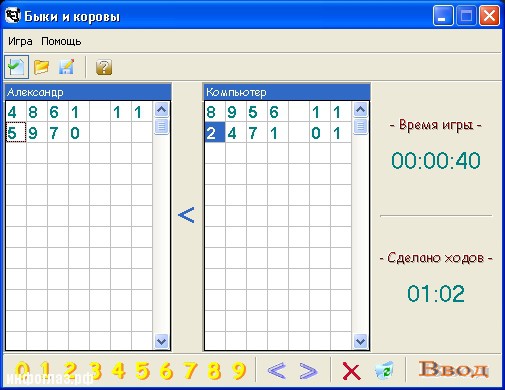
The first player thinks of a four-digit number so that all the digits of the number are different. The goal of the second player is to guess this number. Each move, the guesser calls a number, also four-digit and with different numbers. If the figure from the named number is in the guessed number, then this situation is called a cow. If the figure from the named number is in the guessed number and is in the same place, then this situation is called a bull.
For example, the first player thought of 6109, and the second player called 0123. Then the first player must say: one bull and one cow (1b, 1k).
Each partner has his own word. They take turns. The one who guesses the opponent's number first wins.
2. Gallows
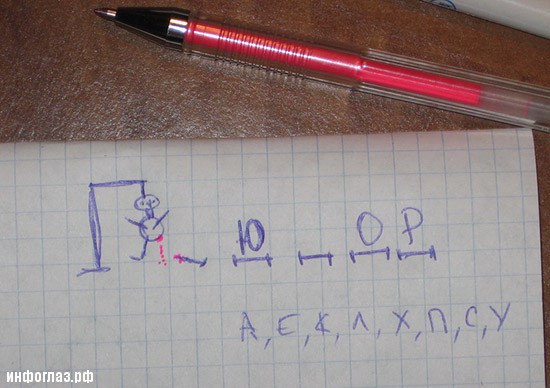
The Executioner is another popular puzzle game designed specifically for two players. For this game, you will need blank paper and a pen.
The first player thinks of a word. It must be an existing word, and the player must be sure that the other player knows the word and is familiar with its spelling. It depicts a series of empty spaces needed to write a word. Then he draws the following diagram, which depicts a gallows with a noose.
The game begins when the second player suggests a letter that can be included in this word. If he guesses correctly, the first player writes it in the right blank space. If there is no such letter in the word, he writes this letter on the side and begins to draw the gallows, adding a circle representing the head to the loop. The opponent continues to guess the letters until he guesses the whole word. For each incorrect answer, the first player adds one body part to the gallows.
If the torso is drawn before the opponent can guess the word, the first player wins. If the opponent guesses the word correctly before the body is drawn completely, he wins, and then it is his turn to think of the word.
3. Tic-tac-toe on an endless field
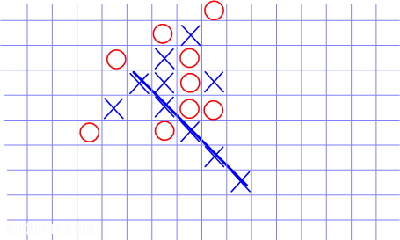
To get rid of the predetermination of the result in Tic-Tac-Toe allows the expansion of the playing field.
On an endless field (a sheet of paper is quite suitable), the players take turns putting their sign (cross or zero). The game ends when one of the players wins or if the field ends.
The winner is the one who manages to line up five of his signs in one line, straight or diagonal.
If you play computer games, you can easily guess which creators have given this extended version of tic-tac-toe a lot of time.
4. Labyrinth
The field can be square or in the form of a pyramid. If desired, you can come up with more bizarre forms.
On the playing field, participants take turns putting lines one cell long - vertically or horizontally.
One of the participants who closed the square (placed the fourth component of it), puts his sign (cross or zero) in this square and walks again.
The task of the players is to put as many of their signs as possible, the winner is the one who, after completely filling the field, has more of these signs.
The more complex and larger the field, the more interesting and unpredictable the game is.
5. Sea battle
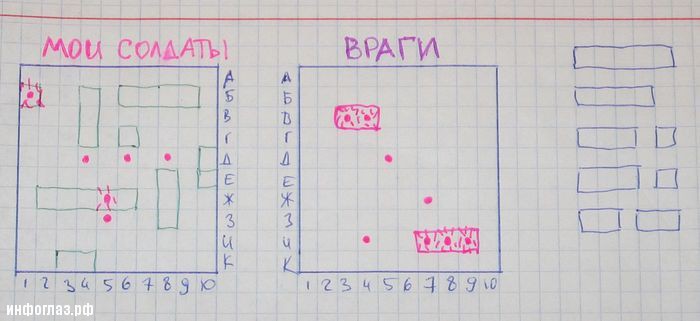
The goal of this game is to destroy enemy objects (ships). Two people are playing. The events of the game take place on 2 square fields 10x10 in size. One of the fields is yours, the other is your opponent. On it you place your own objects (ships) and the enemy strikes at them. On the other field, the enemy places his objects (ships).
Your armed forces, as well as enemy forces, contain the following objects (ships):
1 deck (size 1 cell) - 4 pieces
2-deck (size 2 cells) - 3 pieces
3-deck (size 3 cells) - 2 pieces
4-deck (size 4 cells) - 1 piece.
Objects (ships) cannot be placed side by side, that is, there must be at least one free cell between two adjacent objects (ships) (note that the enemy cannot place objects (ships) side by side either).
When all the preparations are completed and the objects (ships) are placed, it's time to start the battle.
The player whose objects (ships) are located on the left field has the first move. You choose a cell on the opponent's field and "shoot" at this square. If you sank an enemy ship, then the opponent should say “killed”, if you wounded the ship (that is, you hit a ship with more than one deck), then the opponent should say “wounded”. If you hit the opponent's ship, you continue to "shoot".
The game ends when one of its participants loses all ships.
6. Dots
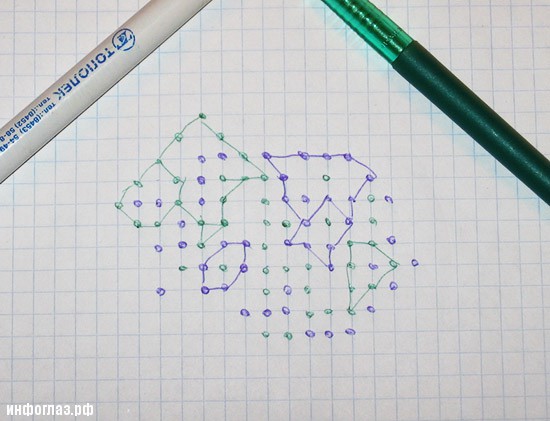
Dots is a game of skill for two or four people. However, it is best to play only two. For this game, you will need blank paper and as many pens as there are players. The goal of the game is to connect the drawn lines into squares, the player who creates the most squares wins the game.
First, create a field on a blank sheet of paper, draw horizontal and vertical lines from small dots at the same distance from each other. A very fast game would consist of ten along and ten dots across. You can make the field as large or small as you like, depending on the level of play and the number of players.
Once the field is created, each player takes turns making a move, drawing one line at a time connecting two dots. Dots can be connected horizontally or vertically, but sometimes diagonally. Once a player completes a square, they put their initials inside the square and get their next turn, and so on, as long as they manage to create a square with one extra line.
Two strategies are possible in this game: first, you can prevent opponents from creating squares. Secondly, you can shape the field in such a way as to be able to create big number squares with one extra line.
7. Football
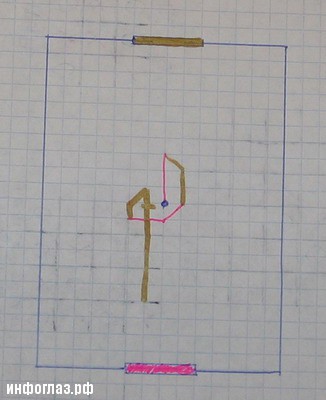
To play football, you need a checkered piece of paper that will serve as a field. Two people are playing. The gate is six cells in size. The game starts at the center point of the field (leaf). The first move is played by lot.
A move is a broken line consisting of three segments, each of which is a diagonal or side of a cell.
Lines cannot be crossed or touched. If the player cannot make the next move, then the opponent breaks through the penalty: a straight line of six cells (vertically, horizontally or diagonally).
If, after a free kick, the ball stops on an already drawn line, or the player cannot make a move, then another free kick is taken.
They play until the first goal.
8. Chain
The task is to come up with a chain of metagrams for a given pair of words that turns one of these words into another. Each following the word is obtained from the previous one by replacing exactly one letter. The winner is the one whose chain is shorter. This game was invented by Lewis Carroll, the author of Alice in Wonderland. So, the GOAT turns into the WOLF, the FOX, the LEOPARD and other animals.
In 17 moves, NIGHT changes to DAY.
In 11 moves, a RIVER turns into a SEA.
For 13 from the DOUGH you can make a BUN.
Traveling through time will take 19 moves: MIG will turn into an HOUR, then into a YEAR, then a CENTURY will arise, and finally an ERA will turn out.
9. Balda
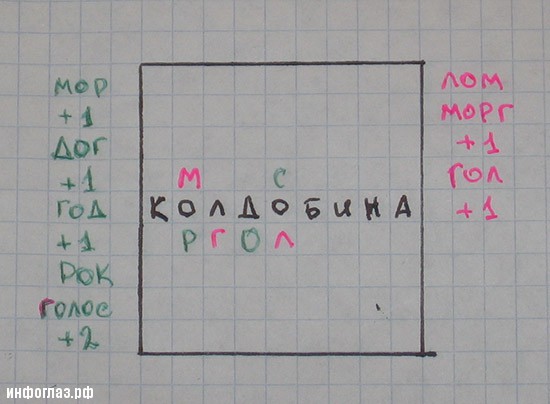
The first player writes a letter, the next player adds a letter in front or behind the written letter, and so on. The one who, as a result of the substitution of whom, a whole word is obtained, loses. Letters need to be substituted not just like adding another letter, you must have in mind some specific word in which the combination of letters written by you occurs. If the one who must make the next move cannot come up with a single word with the combination of letters that was formed before his move, he must give up. In this case, the player who wrote the last letter must say what word he had in mind, if he cannot name the word, then he loses himself, if he named it, the one who surrendered loses. The one who loses the first time receives the letter B, the second time - A, etc., until the word Balda is obtained. The one who becomes Balda first loses completely.
Naturally, you can play not only on paper, but also verbally.
10 . Football 8x12
A field of 12x8 cells is drawn. The dots in the middle of the short sides are the gates. The first move is exactly from the center of the field. They move alternately placing a dash on one cell (along a line or diagonally). If the move ends at a sketched point (that is, through which they have already walked - for example, the center of the field), then the right is given to one more dash, and so on, until the move ends at an empty point. The sides are considered to be sketched points (that is, the ball “bounces off the sides”). The goal is to score the ball into the goal.
An additional rule that we came up with in the class is that putting the ball into a position from which it is impossible to get out is an illegal move (for example, a move to a corner). If this is the only move a player can make, then this is his loss.
Each field is played for one goal (if desired, for more, but practice has shown that it is better to play for one goal after all). The convenience of this game compared to standard football is that it takes up little space and you can also use a partially written sheet for it.
11. Maze with objects
Two are playing. Players draw two 10x10 fields. For convenience, you can assign the designations to the cells: a, b, c, ..., i, k - horizontally and 1, 2, 3, ..., 9, 10 - vertically. (Helps with communication on the game). On one field, a labyrinth is drawn, along which the opponent will walk. The second, while empty, field is the opponent's labyrinth, along which the player himself walks. It marks the objects of the enemy's labyrinth explored during the game. The goal is to take the treasure out of someone else's labyrinth faster than the opponent will take the treasure out of yours.
Here there is an opportunity to simultaneously prove yourself both as an adventurer and as a "owner of the dungeon."
Maze Requirements:
Between the cells there can be walls, which, in fact, form a labyrinth. In addition, the entire labyrinth along the perimeter is also surrounded by a wall, which is called the “wall of the labyrinth”.
The labyrinth should contain:
1 Crossbow
1 crutch
4 exits from the pits (each pit uniquely corresponds to one exit)
3 False Treasures
1 Real treasure
4 exits from the maze on each side.
In addition, each participant has 3 grenades at the beginning of the game.
Map example:
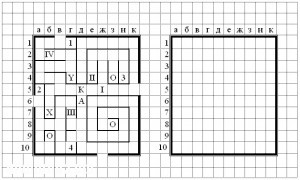
Game process.
Players tell each other the coordinates of the points from which they would like to start the game.
The players take turns. During a turn, a player can move one cell to the right, left, up or down, if the cell in which he is and the one he wants to move to is not separated by a wall. If such a wall is still present, the player is informed about this and he remains on his cell until the next move. If this wall is a maze wall, this is reported separately. However, by prior agreement, you can not make a distinction between the inner walls and the walls of the labyrinth and exclude the concept of "maze wall", but this can greatly delay the game. By spending one grenade, the player can eliminate any wall (including the labyrinth wall) until the end of the game. You don't need to discover it first. Let's say, having intuitively felt that there is a wall on the right, the player may not spend a move to go to the right and make sure that it exists. He can immediately use a grenade, and even then there will definitely not be a wall there. But it may be that it was not there, then the grenade is still considered spent. Throwing a grenade counts as a move. You cannot throw a grenade and move on the same turn.
After the player has moved to a new cell, the opponent informs him that he is on the new cell (and only one object can be on one cell).
These can be (with examples of notation):
a) crossbow("AND"). After visiting this cell, the player begins to "limp" and the enemy during his turn (already attacked) can take +1 action (move, throw a grenade, stumble on a wall). The crossbow works once, but its effect lasts until the end of the game.
b) crutch("Y"). Visiting this cell gives the player himself, starting from the next turn, to perform 1 more action per turn. This is not a cure for the action of a crossbow, but an independent object. The crutch works once, but its effect lasts until the end of the game.
The actions of the crutch and crossbow add up. That is, visiting both of these cells gives the same result as not visiting either of them. If you have found a crutch, and your opponent has a crossbow, then in a turn you can already do three actions (not four!).
in) trap("K"). Allow three moves. Those. while you are getting out of the trap (more correctly - traps), the enemy makes four moves, after which you can again move. The presence of the opponent's crutch allows him to make eight moves. If you fall into a trap after being wounded by a crossbow before, the enemy takes only four turns (permanently skipping moves does not work, because you still do not move). The trap triggers every time a player visits a square with it.
G) you fell into a hole No. 1, 2, 3 or 4. ("1,2,3,4") - instantaneous movement (in the same move) to the cell "Exit from the pit No. 1, 2, 3 or 4" ("I, II, III ,IV"), respectively. The exit coordinates are not reported to the player. He continues the game from the cage with the exit from the pit and determines his location by indirect signs. If the player got to the “exit from the pit” cell without falling into the pit itself, but simply “stumbled”, he is informed about it. Now, having fallen into the hole with this number, he will know where he will appear.
e) you found a treasure. False (“O”) or true (“X”), can only be found out by leaving the maze.
To exit the maze, you can use any of the exits that are available, one on each side, or break through a new one using a grenade. (However, we can agree that the walls of the labyrinth do not take grenades, although they are spent).
A player who exits the maze on his turn (accidentally or intentionally) is told that he has exited the maze. If at the same time he has a treasure in his hands, it is also reported what kind of treasure it is: false or real.
Only one treasure can be carried at a time. At the same time, the actions of the crossbow, crutch, trap are not canceled. You can’t throw treasure wherever you like, but you can change one for another. It is not necessary to take the treasure. If you find yourself on a cell with a treasure and decide to take it, you need to inform the enemy about it.
The maze must be designed in such a way that it is possible to visit each cell and exit the maze without using grenades, starting the game from anywhere. You can't build traps: when a player, having fallen into a hole, leaves it into a closed space from which he cannot get out without using grenades. The trap can be placed anywhere.
After leaving the labyrinth, the player can only enter the exit from which he left. However, the option with the possibility of re-entry through any exit also has the right to exist. In this case, you can fence off areas that can only be reached through a certain entrance to the labyrinth, if the starting point is outside them.
12. Nonsense
And even the seemingly stupid game "Nonsense" carries a deep meaning if you play it with the whole family. Each player receives a piece of paper and writes the answer to the question “Who?” at the top. (Winnie the Pooh, Behemoth cat, neighbor Uncle Vasya, etc.). Then the answer is folded in such a way that it cannot be read, and the sheets are passed around. The next question is "With whom?" Then follow: “When?”, “Where?”, “What did you do?”, “What came of it?” When all the answers are written, the pieces of paper are unfolded and read. "So what's the point of all this?" - you ask. If the whole family laughs at the resulting nonsense, if parents and children are interested and have fun together - isn't this the main, most important meaning of any family games?
13. War of viruses
Virus War. game for two more is possible, but an even number of players is desirable, otherwise one quickly becomes a victim), on the field 10*10 ( again, you can do more, then even more interesting), “viruses” is denoted by crosses, circles and other evil spirits (each player has his own color or figure). Three "viruses" are exposed per turn. Viruses begin their reproduction from opposite corner cells of the field. You can put a "virus" only next to your other "live virus". If there is a "virus" of the enemy nearby, then you can eat it by painting the cell in your color. The enemy can no longer “overeat” this cell for the second time. Such formations are called "fortresses". If the "fortress" touches at least one living virus of its color, then you can create new "viruses" anywhere farther from it or there is an enemy. The goal of the game is the complete destruction of the living forces of the enemy. If both sides manage to hide their live viruses behind the opponent's fortress of eaten viruses, the game ends in a draw.
"Bedbugs". Virus Warriors variation. Can be played by 2 to 6 players, but 4 players are optimal. They play on a notebook sheet, each player must have his own color. The game begins with drawing the "main bug" - a cross surrounded by a frame and the "headquarters" surrounding the "main bug" of 8 crosses in the corners of the sheet. Further, you can make 5 “walkers” per turn, and not 3 as in the “war of viruses”. The game is played to destroy the "main bugs". But the most interesting thing about this version of the game is that the players who play by default, each for themselves, have the right to make alliances and break them as the situation or personal preferences change. Often a good "political" intrigue in this variation brings more dividends than the combinational class of the game. Possible addition: a player who has built a square of 8 bugs can place a new "main bug" in the center, while the old one is painted over in the player's color. Such a revolution allows you to save your army from defeat, if the enemy gets close to the old "main".
"War". A very difficult variation of "virus warriors". Can be played by 2 to 6 players, but 4 players are optimal. They play on a notebook sheet, each player must have his own color. The game starts from the "generals", which are denoted by the letter G and are located in the corners of the sheet. For each move, the player may place:
4 infantrymen (indicated by the letters P);
2 horses that are placed with a letter as in chess (and are denoted by the letter K);
2 tanks that move through one cell (you can also diagonally) (indicated by the letters T);
1 plane that moves through 4 squares horizontally, vertically or diagonally (indicated by the letters C).
During any turn, you can abandon one type of troops and make an extra one extra walker with another type. For example, you can go immediately 3 more times by plane in one turn, refusing, respectively, from all infantrymen, from all horses and all tanks.
Unlike the “war of viruses”, new fighters can only be placed next to living fighters (or next to a “living” fortress) of the corresponding type, provided that they have live connection with the general! That is, troops without control do not fight. Communication can be carried out through another type of troops. They play, of course, to destroy the generals.
14. Pyramid
Two players play. They take turns writing words in the form of a pyramid according to the crossword rule, in addition, it is forbidden to repeat the same words. They start with a three-letter word, under the word you can write a word of the same length or one letter longer. Under each word, you can only write a word of the same length once, the next word must be one letter longer. After the opponent's move, the player carefully analyzes the resulting game word pyramid and tries to make a word of at least three letters, taking for it the first letter from an arbitrary level of the pyramid, the second from the next level below it, etc. one letter from each next level. This word must also be a common noun in initial form and not an abbreviation (not an abbreviation for the type of traffic police). The player who finds such a word adds as many points to his score as there are letters in this word. Then the next round begins, and so on, until any player scores 12 points. He becomes the winner.
An example of one round of this game with the words: the 1st player writes the word LUK, the 2nd writes the word MIG under it. The 1st player needs to find a 4-letter word already, he writes the word SHAWL. Both players try to pick up words from already used letters in order not to give the opponent a chance to win the round. Here the 2nd player is carefully looking to see if it is possible to make up some word, but all sorts of nonsense like KISH, LIL, YUM, etc. is obtained. Then the 2nd player writes the 4-letter word SHILO (and could also write the 5-letter word):
The 1st player analyzes the pyramid... He sees the words GAI, IL and SOUTH, which, according to the condition of this word game, do not fit, and does not notice the word KILO! The pyramid has another level:
Player 2 sees the words FACE and THORN, then notices the word KILO... And suddenly finds a beautiful 5-letter word LILY! It adds 5 points to the score of the 2nd player.
Such games on paper with words develop attentiveness and the ability to combine words.
15. Tanks

Two players draw 7-10 "tanchiks" each. or? starships?, each on its own half of a double notebook sheet (preferably not in a box, but in a ruler or an empty A4). Having placed the army, the players begin to fire at each other in the following way: the shot is drawn on their own half of the field, then the sheet is folded exactly in the middle, and the shot, visible through the light, is marked on the second half of the field. If it hits a tank, it is knocked out (the second? knocking out? fatal), and if it hits it exactly, the tank is immediately destroyed.
Each successful shot gives the right to the next; in some versions of the game, you cannot fire the next shot at the same tank.
After a preliminary shooting, the game very quickly goes into the stage of "blitzkrieg", or rather, a rapid denouement. The winner, of course, is the one who first shot the opponent's army.
16. Barriers

A simple tactical game, the essence of which is the positional struggle for space. On an 8x8 field (i.e. the size of a chessboard), players draw small lines one after another that overlap any 2 cells in a row: i.e. for example, player 1 draws a vertical line occupying e2 and e3.
Player 2 does the same, but his line cannot cross or touch any existing ?obstacles?. As the field fills up, there is less and less free space, and at the end a sober calculation is needed to complete the game. A player who can no longer place his trait because everything is already blocked, losing.
17. Headbands
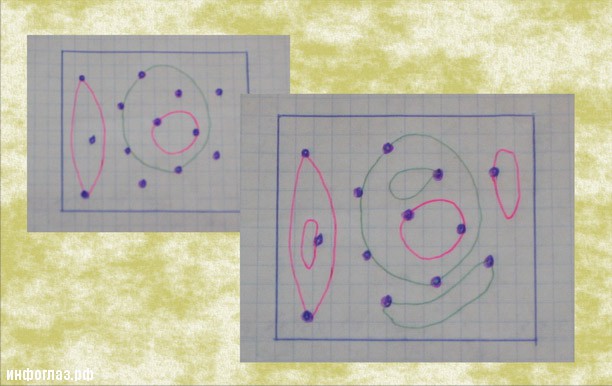
A simple and rather fun game, built on the same principles as the parade of coins, but completely different in form.
On a small field (it can be a square or a rectangle of arbitrary size, it's not particularly important), players place about 15-20 points in various places, although more or less evenly.
Then the first player draws a rounded but free-form rim that goes through at least 1 point. The maximum in the classic version is unlimited, although I would recommend giving a maximum of 4 dots per border.
The next player draws their own rim, the only limitation? it cannot intersect with already drawn ones. The rims can be drawn inside the rims, or, conversely, surround existing ones, the main thing is that they do not intersect. After a while, there is very little space left, and the one who draws the last rim loses.
A variation of this game is the rule to draw circles that cover only 1 or 2 points, no more.
18. Digital Wars
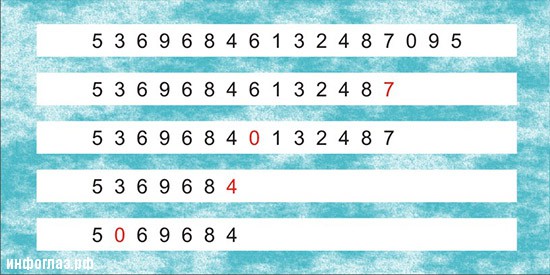
In this game, the main character is the eraser. You will have to wash constantly, this is a war, and losses are inevitable. Many numbers will die for your victory!
The game is very fast and variable, and, in general, very simple.
You write a series of numbers from 0 to 9, in any sequence, in any combination. The length can be whatever you want, I recommend starting with 20. For example, it can be a series of 5,3,6,9,0,8,4,6,1,3,2,4,8,7,0, 9.5? or any other.
On their turn, a player can take one of two possible actions in the game:
- change down one of the numbers, up to a maximum of 0 (there are no negative values in the game);
- erase any zero and all the digits to the right of it, thus reducing the length of the strip.
The one who destroys the last zero loses.
19. Dots and squares
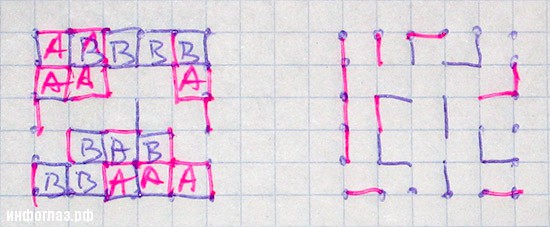
The author of this game, the popularizer of mathematics and sciences, Martin Garner, considered it ?pearl of logic games?. Without sharing his opinion, however, it is quite possible to call the game one of the best tactical games, interesting at any age.
Playing field? rows of dots from 3x3 to 9x9. It is better to start with a small field, and after feeling the taste, increase the size. The rules are very simple: the players connect two dots with a line, and when the player can close the square, he puts his sign in it (for example, the first letter of his name).
Closing the square, the player gets the right to an additional move, until he draws a line that does not close anything. At the end of the game, who has closed more squares is counted, and the winner is determined.
With seeming simplicity, the game is a good space for combinatorial play, especially on the fields of 5x5 and more. The essence of winning tactics? to force the field with semi-closed constructions, to sacrifice, it was necessary to carry, several squares in favor of the opponent, and then, when there is practically nowhere to bet, to force him to make an unfavorable move (not closing anything)? and after that close most of the squares in one series.
20. Troika
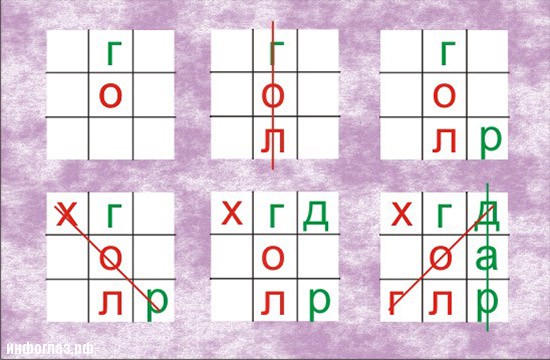
The simplest word game, according to the principle of tic-tac-toe, only with letters.
On a 3x3 field (then try other sizes), two players bet any one letter each, and the winner is the one who, by the end of the game (when all the fields are filled), will be able to write diagonally, vertically or horizontally more well-known words of 3 letters.
The game is useful for children who are learning to write. For adults, it does not have a rather small competitive value, but players with humor will find a lot of fun. For children, you can play the option? who will be the first to create a word, and not who will have more words.
21. Racing

More complex and long game, built on the same principle as other paper coordination games: the movement of a pen standing vertically across the sheet from a slight click.
On a sheet (single or double) is drawn race track(Race), in the form of two curving, uneven circles, repeating the outlines of each other, 2-3-4 cells wide (depending on the number of participants). Then, in an arbitrary place of the resulting ring, a start / finish line is drawn, from which racing cars start.
With short, neat strokes, the racers move around the ring, overcoming bends and special obstacles, flying into a ditch, entering the field again, and as a result, one of them comes to the finish line first and reaps the laurels.
Each time a rider's line touches or crosses a line boundary, a cross is placed at the intersection and the rider skips the next turn by turning his car so he can continue the run. There are 5 such intersections for each car in stock. (5 hit points) and the sixth encounter becomes fatal.
In addition, there can be any obstacles on the track? for example, high-risk zones: flying into such a zone, the car takes more damage, and loses two hit points. Or special obstacles that protrude from the edges and make the passage narrower, or, on the contrary, stand in the middle and force cars to squeeze into
It is also possible to enter touch points points, or rather, small circles, which the car must get into when passing by (i.e., through which the line must pass). The figure shows all the listed complications of the track at once, and it is clear that the race is still far from over.
You can invent and introduce your own rules, new obstacles, and if there are 4 or more participants, you can even arrange a racing series by making several tracks, and in between allowing players to purchase equipment, for the amount of points depending on occupied place. For example, buy extra hit points or attacking spikes, and take 1 hit point from the car you overtake.
22. Golf
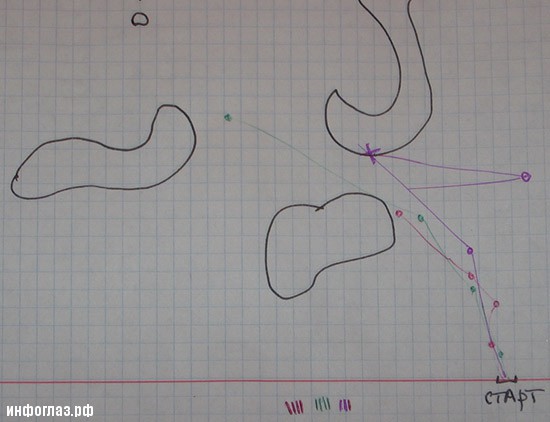
Players start from two points next to each other at the bottom of a double sheet standing upright (see picture).
Everyone plays with a pen of his own color, and what is the task of each? for the minimum number of strokes (lines from the handle sliding along the sheet) to bring the ball into the hole. The hole is at the opposite end of the field, i.e. top of the sheet. And a person with good coordination needed a maximum of 4-5 strokes to drive the line into the hole.
But in advanced versions of Golf, the path to it is not so easy, because long straight lines are protected by hills that act as a buffer and do not allow the player. When hitting a hill, the enemy performs a rollback i.e. shoots the line of the violator in any direction, and he is forced to continue his series of blows from the place where this line came. Or, perhaps, 1 or 2 extra moves are attributed to the track of the one who hit the hill.
cream on the field 8x8
Sim
Maxit
.
Logic game "Four colors", exists as online game to flash.
All of them are also suitable paper games for kids. In these articles, you will read about the rules and methods of winning and find links to online versions of these pencil and paper games.
In the world, such paper logic games, like mazes, Japanese puzzles, (Japanese crosswords, nonograms or cell drawing), sudoku, kakuro, sea battle and hitori. (To be more precise, these are not games, but puzzles.) Paper games do not require special knowledge and can be solved with a pencil and paper. With patience, paper games can be solved even by a child.
Scientists have found that playing with paper games increases intelligence, but on the condition that a person solves many different puzzles. We also offer you new games that are no less interesting than traditional pen/pencil paper games.
How to print a picture with a paper game? If you have Internet Explorer, then just put the cursor on the picture and click on the printer icon that appears. In other browsers, you can select an image by dragging the mouse over it and choosing the File / Print... (Ctrl-P) menu. Or right-click on the picture, save it to disk and then print it.
To open a document in a new tab, hold down the Shift key while clicking.
Logic games on paper
Paper Sudoku is the most popular game in the world.
The game is more interesting than nima - logic game on paper "Dead end". Take your opponent to a standstill!
"Sea of numbers", "4 signs", "Number and value": arithmetic games with a pencil for two. Author - Yuri Gurin.
Very simple like him logic paper game "Dots", invented by Yuri Gurin.
Our option logic game tic-tac-toe Silverman. There is an online version of the game on our website.
Our option super him games. This variant of the game does not have a simple winning strategy.
English mathematician Gustav Simmons invented paper sim game. We calculated it and wrote an article about this game on a graph.
Martin Gardner called this logic game on paper "Dots and squares" ingenious. We programmed it and give you positions to solve.
"Maxit" or do your best. Cross off the numbers in this game and add them to your total to make it bigger than your opponent.
Game of logic "Krem", these are advanced tic-tac-toe on chessboard. A complex game with simple rules.
Download our free pack of logic games on paper. 3 games, 4 difficulty levels.
Logic game on paper for children "Go around all the empty cells"
In this series of paper games for kids, choose a starting cell and go through all the empty cells avoiding obstacles. Each move is made horizontally or vertically through all the cells that have not been passed until it stops at the passed cell, the occupied cell or the edge of the field. The solution in all these games on a piece of paper is the only one. For children from 10 to 90 years old.
We had a chance to go by train this summer. Here we remember a lot interesting games on paper with a pen.
That is why our eldest daughter liked to ride the train.
In this regard, I propose today to recall with you the good old games that you can play on a regular piece of paper. Most often it is a leaf in a box.
Nowadays, people are not used to being bored ...
After all, they have so-called gadgets! And now aunts and uncles will gather, or girls and boys for some reason, sit in a row and everyone has their own gadget. And what, you ask, were going to? It's not clear 🙂.
But if you take out the most ordinary piece of paper and a pen with a slight movement of your hand, then you can ...
Wow, what a wonderful and fun time! It is wonderful to notice this from the word. Well, in a sense, take, suddenly notice each other and play.
The most successful place for such games, as already mentioned, is travel. Even small ones will do. For example, by subway or train.
And don't forget to bring something hard with you! For example, a book. To have somewhere to put a leaf.
So. Games. Here we will talk about our favorites. Most of them I remember from my childhood. The rules of some were peeped in the book "The Best Board Games for Children and Adults." We always have it with us when we travel, and we have already talked about it.
But basically, this is still my presentation of precisely our rules of the game. Therefore, in some places they are very different from the book ones.
Hangman game - a game for two or a small company
Seven-year-old Marina and I like to play gallows and sea battles most of all. That's why we'll talk about them first.
And we won’t talk about tic-tac-toe at all. After all, everyone knows them. Truth?
Preparing for the game
Each player guesses a word and depicts this word in the form of dashes. One dash equals one letter. Like this.
Yes! If a child is participating in the game, who is most likely to write “malAko”, I recommend giving him some book that is at hand so that he chooses words from those written there. In order to avoid incidents, so to speak.
Game progress
Actually, this is a game for two. But the three of us played it.
Players take turns calling their opponent a letter. If there are more than two players, the order is established. For example, clockwise.
So. The first player says to the second:
If the word made by the second player contains the letter “O”, then he puts this letter in its proper place, replacing the dash. Like this:
If there is no such letter in the word, the first player writes down the letter “O” for himself in order to remember that this letter is not in the guessed word, and the second player draws one stick in the gallows picture. Here's one.
Each unguessed letter = stick in the picture.
My family and I made a unanimous decision that we did not want to play the gallows. After all, our company is pleasant and we don’t want to hang anyone, even on paper. So we replaced the gallows with a launch into space. Like this:
There are exactly the same number of sticks.
After the first player has not guessed the letter, the move goes to the next one. And so on.
Purpose of the game
Guess the word of the enemy before you were sent into space (hung).
Sea battle - the rules of the game on paper
If in the previous game the leaflet does not have to be in a box, then according to the rules of the game “ sea battle The cell is still needed. However, if there is no checkered paper, it's not scary! You can draw the cells yourself. After all, you do not need a whole sheet of cells. And two fields 10x10 for each player.
Preparing for the game
Each player has their own sheet.
There are two fields on the sheet. Like these ones:
We mark the verticals and horizontals of the fields according to the chess principle.
We sign letters from above to the cells. We start with "A" and continue alphabetically.
The letter "Yo" is usually omitted.
Well, on the left we number the horizontals.
One such field will be needed to place your ships. The other is for guessing enemy ships.
Players place their ships on their field. They should be:
Four-deck - one (four cells)
Three-deck - two (three cells)
Two-deck - three (two cells)
Single-deck - four (one cell)
Ships must be placed so that there is at least one empty space between them.
All is ready?
Then to battle!
Game progress
Players take turns calling the coordinate of the cell they "shoot" at. For example, our opponent says:
We are looking for a box on the field with our ships in the fifth line in column "A".
So we answer:
And just in case, we mark this cell with a dot. Like, the enemy has already walked here.
And the enemy does the same. After all, he needs to remember where he “shot” and where not yet.
After a miss, the turn passes to another player.
If the enemy “hit” a cell with a ship, then: if the ship is multi-deck, we say:
And we cross out with one slash the cell of our wounded ship.
The enemy does the same and continues to “shoot” until the first miss.
In the event that the enemy "hit" the entire ship, we, brushing away a mean tear, report:
Purpose of the game
Hit all enemy ships first.
Bulls and cows game - rules
This is my favorite paper game!
However, not necessarily on paper. There are even analogues of this game in children's games. Once I came across such a game in a very pleasant children's quest game, downloading it for my daughter Marina.
The numbers in this game have been replaced by characters from the Cheburashka cartoon. The game did not lose anything, so it was difficult to drive me away from it 🙂
So. Bulls and cows.
Preparing for the game
Each player guesses a predetermined sequence of numbers.
For example, we guess four numbers. Yes! One condition - the numbers should not be repeated.
Game progress
Players take turns guessing about the sequence that the opponent has guessed.
For example.
Player 1 guessed 4567
A Player 2 - 3079
The first player moves.
– 5043! he says.
And the second one compares the hypothesis of the first player with his hidden sequence.
To do this, he signs the number suggested by the opponent under his hidden number and checks all four positions. Like this:
If the opponent called the correct number in the correct position, then this is called one bull.
And if the number is correct, but is not in its place, then this is called one cow.
Player 2 counts all his bulls (1 bull is zero) and cows (1 cow is 3) and reports the result to player 1:
- 1 bull, 1 cow!
Player 1 records:
Purpose of the game: guess the opponent's number sequence first
Football by cells
Preparing for the game
You need a piece of paper exactly in the box. We draw a football field such that it is divided in half. We designate the middle of the field. And the gate (6 cells).
We take colored pens (otherwise, it is not necessary, we need it so as not to get confused in the order of moves).
Let's play the first move.
Game progress
The first player walks from the middle of the field with a line (it can be straight, it can be broken), consisting of three segments. It can be the sides of the cell or the diagonal. The main thing is that the segments must be connected in series.
The next player from the end point of the line makes the same move in the direction he needs.
If the player has nowhere to go, a free kick is punched - a straight line of six cells.
In this case, you can cross the lines. If the free kick ends on an already existing line, or the opponent has nowhere to go again, this is another free kick.
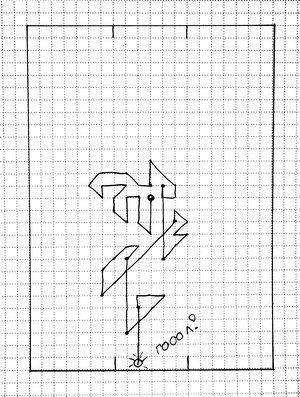
Purpose of the game
Be the first to score a goal against your opponent. Yes! Be sure to agree in advance what is considered a goal - when the line has reached the nearest side of the goal cell, or - to the far side.
Corridors game
Preparing for the game
you will need a piece of paper in a cage and pens. Draw a square or rectangular field on the sheet.
Game progress
The first player draws a segment in an arbitrary place. One move is equal to one side of the cage.
The second also draws in an arbitrary place - his own.
Here, I note. Actually, the game is called "corridors". And judging by the name, it probably wouldn't hurt the second player to continue the segment of the previous player. But for some reason, this was not mentioned in the book. And we played like that. You can try to draw a continuous line. Perhaps this will be even more interesting. Experiment!

When any of the cells is surrounded by segments on all sides, the player who managed to lock the cell puts his icon in this cell - “cross” or “naught” and gets an additional move. He walks as long as there is an opportunity to put new "crosses" or zeros. In this game, cells are dealt with one at a time.
When the whole field is cleared (well, or the players are tired of playing, it's time to go out, etc.), the number of zeros and crosses is counted.
Purpose of the game
The winner is the player whose icons (crosses or zeros) turned out to be more.
Game "Lock the cage"
Preparing for the game
Very similar to Corridors. Draw a square or rectangular field on the sheet.
Game progress
The first player also draws a segment in an arbitrary place. One move is equal to one side of the cage.
And the second from any end of the existing segment draws the next segment.
The nuances are as follows: you can “lock” several cells at once. After the player "locked" the cell, he does not continue to walk - the move passes to the next player.
And - according to the rules of the game, we do not put crosses and zeros here, but we put the first letters of names here. Which, by the way, allows us to play as a company.
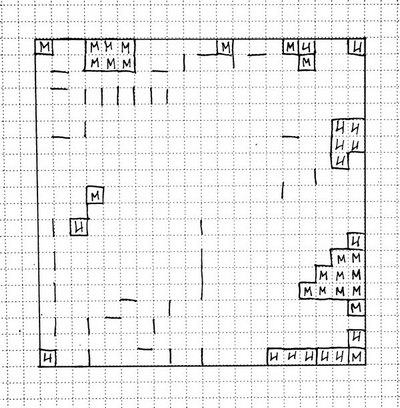
At the end of the game, count the number of letters on the field.
Purpose of the game
The winner is the player whose icons (the first letters of the names) turned out to be more.
On this, perhaps, everything.
Today we told you about our most favorite and interesting games on paper. I hope this helps you pass the time on the road or while waiting for fun and interesting!
Yes! Soon there will be an article with the most interesting board games for the whole family and for two.
Paper games are a category of games that do not require any toys or objects other than a regular sheet of paper and pencils. Such games are very convenient, because you can play anywhere: on the road, in transport, in line at the clinic, at a break at school, and even indoors in bad weather.
Such leisure is useful for the development of logic, thinking,. No wonder that almost all parents at one time played such games on paper. The purpose of our article is not to encourage children and adults to learn how to spend their leisure time, but it is still worth using games on paper for the development of children.
The value of paper games for a child
Playing activity occupies a central place in the life of a child. Games serve to cognize the world around us and develop various skills and abilities in a child.
Games on paper are deservedly related to. Such games are not an empty pastime, they contribute to the development of children:
- and observation.
- The ability to concentrate your attention.
- Logic and reasoning skills.
- Creative thinking.
- Spatial imagination.
- Writing skills.
- Memory.
- Accuracy.
- perseverance.
It is wrong to consider games on paper as yesterday. Sometimes it is such entertainment that can actively stimulate the work of the child's brain. No computer game can compare with paper games in terms of the elegance of tactics and maneuvers of both players.
Paper games can be competitive or creative. And they can also combine both features. They can be conditionally divided into:
- Strategic.
- Brain teaser.
- Verbal (intermediate results and notes are made on paper).
Paper games are a kind of simulator for useful skills for children. They can be of varying complexity, some of them, in terms of building a strategy, are equated to a game of chess.
Benefits of paper games for kids
Paper games are interesting for both children and adults, in addition, they have a number of advantages:
In our age of technological progress, almost everyone already has their own tablet, on which they spend as much free time as possible. By the way, such a pastime negatively affects the health of the eyes of children. But the same cannot be said about games on paper.
Here, in a playful way, children develop both spatial imagination, and logical thinking, and memory, and attention. Games on paper, like the mathematical sciences, "put the mind in order," as Lomonosov said. Yes, and playing them is a great pleasure, but in fact, these are all mathematical problems.
What kind of children are interested in paper games, at what age can they play
Many adults mistakenly believe that paper games are very difficult for toddlers, and are more suitable only for school-age children. But among the huge variety of these games, there are those that even three or four year old children can play.
For example, they can easily be taught to play "Multicolor Flower" or "Snake". Having played several times, the child understands that in order to win, you need to choose the tactics of the game and think over the moves ahead. And the simple game "Tic-Tac-Toe" for a small child is one of the first mathematical problems. For older children, more complex games will be interesting, in order to win in which you need to use ingenuity and logic. 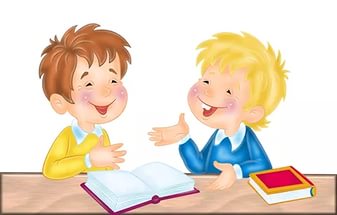
In order for any game to be both useful and interesting for the child, adults, when choosing it, should:
- Consider the age, developmental level of the child and his interests. You need to start with games that will be simple for the child. To interest him in the game, he must feel the joy of victory.
- The child should be a full-fledged player, and not play only with the help of an adult. During the game, adults should not make decisions instead of the child. He must come to the correct answer himself, even if he is repeatedly mistaken.
- In games on paper, you need to add variety and gradually complicate them.
- A child may not be interested in the game if he has poorly developed qualities necessary for the game (for example,). Therefore, he should be praised more even for small successes, and in case of failure, cheer him up.
- Consider the interests of the child. If he does not want to play any game, then you do not need to impose your choice on him. The interests of children are inconsistent, therefore, if the child has lost interest in the game or was not interested in it at all, you can offer it again after a while.
Where and when can you play paper games
Paper games are very simple and do not require any additional tools other than paper and pencil. You can play them anywhere and anytime. For example, they will help you make good use of your time while in line or in nature. A simple game like Tic-Tac-Toe can be played with chalk on the pavement or right on the sand while relaxing on the beach.
However, it is unlikely that the game will bring pleasure if the child for some reason does not want or is not ready to play. For example, you should not start the game if the child is sleepy or feels tired. The main condition for the game is that the child should feel comfortable and comfortable.
Description of interesting paper games for children
In the memory of parents, there are many games on paper that they can offer their children. If there are any difficulties with this, you can search for a description of games on the Internet. Here we will give some examples of the most common paper games for two. We hope that they will be useful to our readers.
"Flower-eight-flower"
For the game you will need a sheet of paper and several pencils of different colors. First, a flower with eight petals is drawn. Then, in turn, the player paints the petals. Making one move, you can paint over one or two adjacent petals.
The winner is the player who was the last to paint over the petal. The child must understand that his victory does not depend on luck, but on correct calculation. The number of petals can be changed. 
The game is suitable even for younger children preschool age. She develops logical thinking, the ability to hold a pencil in her hand and.
"Dorisovki"
Each player draws any squiggle on the sheet. Then the players exchange leaves and draw some picture from the squiggle (preferably in a different color), so that the incomprehensible squiggle becomes part of the whole picture.
After several such exchanges, it will be interesting to see what the original squiggle has turned into.
You can play the game together, or you can invite more participants. If after ten such “moves” your leaflet finally returns to you, it will be funny to look at the final result of joint creativity. 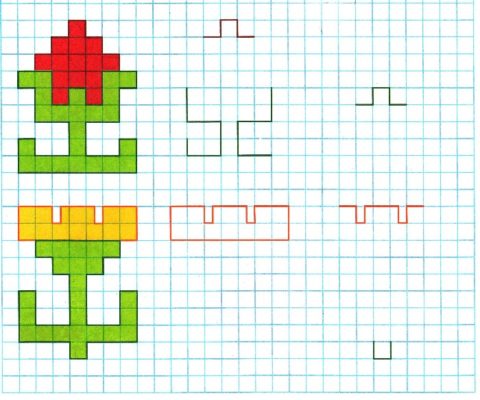
"Points"
To play dots, you will need a piece of paper in a box and two multi-colored pens. Before the start of the game, the boundaries of the playing field are marked on the sheet. It is recommended to make it at least 10 cells vertically and 10 horizontally. Then the players, making a move, draw one point (at the intersection of the cells).
If the player's dots surround some part of the field, then this player circles it and gets the right to make one more move. If the player was able to circle the territory of the opponent, then it passes to him. There are several variations of the dots game.
In some, the points are connected with strictly vertical and horizontal lines, while in others, diagonal lines can be drawn.
The winner is the one who conquers more of the playing field. During the game, the players need to build a strategy so as not only to capture more territory themselves, but also to prevent the opponent from doing so. 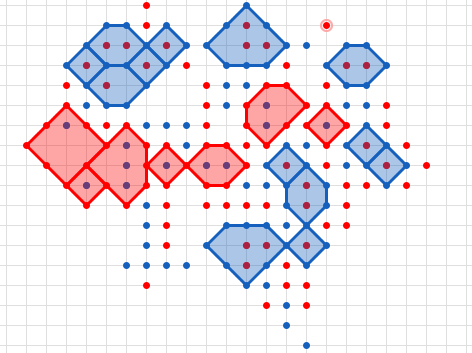
"Labyrinth"
This game bears some resemblance to the game of dots. To begin with, on a regular sheet in a cell, the boundaries of the field for the game are drawn. It may be in the form of a square or other more complex shape. Players put dashes one cell long.
The dashes can be placed vertically and horizontally. Each playing a different color pen or pencil. If the player was able to close the square (cell) with his dash, then he paints it with his own color and gets the right to one more additional move.
The player with the most filled squares wins. 
"Bulls and Cows"
According to the rules of the game, each player thinks of any number of four numbers. In this case, the numbers in it should not be repeated.
The winner of the game is the one who can first guess the number that the opponent has conceived. To do this, each player, making his move, also says some four-digit number. At the same time, if the numbers in the named and conceived numbers match, the player must say: “Cow”. And if the digit of the called number is not only in the hidden one, but is also located in the same order, the player says: “Bull”.
For example, the guessed number is 1234, the player who guesses it, called the number 1475. The first player says: "One bull and one cow." Because the numbers 1 and 4 are guessed correctly, while the number 1 is in its place. The players take turns. In order not to get confused, the results of the moves must be recorded. 
"Tic Tac Toe"
The most famous and popular game on paper. To begin with, a playing field is drawn (three cells horizontally and three cells vertically). Then, making a move, the players put one “cross” or “zero” sign into a free cell (one player puts only crosses, the second only zeros).
The winner is the one who builds a line of their signs first. If the child is tired of simple Tic-Tac-Toe, the game can be made a little more difficult. For example, expand the playing field, make it five by five cells. Or you can make the playing field three-dimensional. To do this, you need to draw a cube, and make each of its visible faces a playing field. There will be three in total. The rules of the game remain the same. And the one who will be the first to collect a line of their signs on any of the sides of the cube will win. 
"Troika"
The three is rather, very similar to the classic Tic-Tac-Toe, but not numbers, but letters fit into the cells.
For this game, a field of at least three by three cells is drawn. Players, making a move, enter one letter in any cell of the field.
In one version of the game, the winner is the one who can be the first to write vertically, diagonally or horizontally a word consisting of three letters. In another variation, the winner is the one who can write the most words. This game can be made a little more difficult by increasing the playing field. Then you will need to enter longer words into the cells. 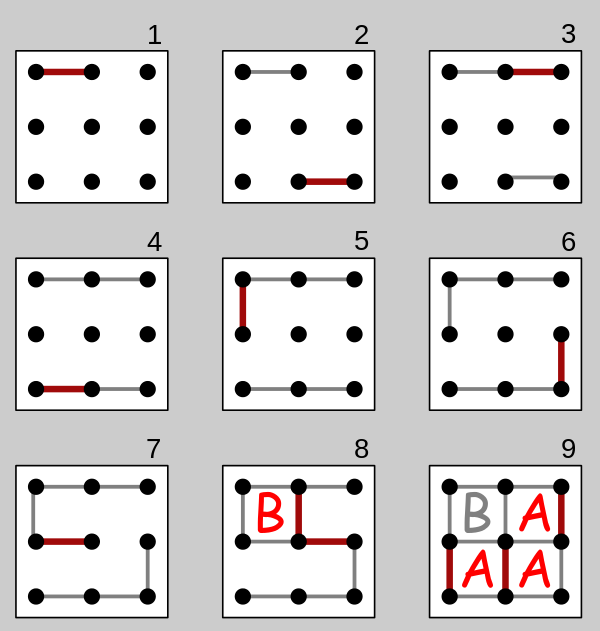
"Gallows"
This entertainment also belongs to the most common and popular paper games for two. They play it together. The first player guesses the second word (noun) and draws as many empty cells on paper as there are letters in the hidden word. 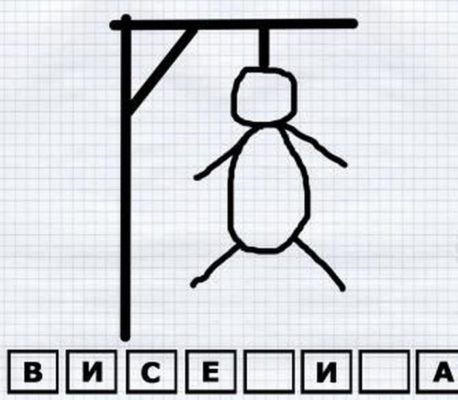
The second player spells out the hidden word. If the letter is guessed correctly, then the first player enters it in the corresponding cell, if not, then next to the word, the gallows scheme begins to emerge (by the same first player). One wrong move (incorrectly named letter) - one dash of the scheme.

If the second player manages to guess the word before the gallows is finished, he won, if not, he lost. Then the players change.
Instead of a conclusion
Someone thinks that games on paper are the last century, that in our time of technological progress they have lost their relevance. But it's not. After all, everyone can find themselves in a situation where the use of modern gadgets is impossible, and in order to entertain children there is only a pen and a piece of paper.
There are a lot of funny and educational children's paper games that can be interesting not only for children, but also for adults. The main advantage of such games is their simplicity and general availability, since, you see, several sheets of paper and several pencils or pens are available almost always - anytime and anywhere. These items, as if by magic, turn into a source of universal fun and amusement.
DANCE ON PAPER
This is a very fun and funny game. For its implementation, several pairs are needed, preferably consisting of a man and a woman or a boy and a girl (the game can be played if there are two pairs). Each pair is given a large sheet of paper (1x1 m in size). It can be any loose paper or newspaper.
To the melodious music, the couple stands on the paper and performs a slow dance in place, trying to keep their feet off the floor. Then the music stops and the paper is folded in half, the couple dances again, already more tightly pressed against each other. The paper is folded up until it is possible to stand on it, performing a dance, to one partner with a partner in his arms, and so as not to go beyond the edges of the paper (some men, in order to win, manage to stand on one leg, and even with a partner on hands).
The couple that has been able to hold out on a small piece of paper for the longest time wins and receives a prize.
"THE MUMMY OF THE PHARAOH"
Another humorous game that uses paper, moreover ... toilet paper. Participants are again divided into pairs (two pairs are enough for the game). In a pair, a “mummy” and a pharaoh are selected.
Each couple is given a roll of toilet paper. Fast music is on. And on a signal, the "pharaoh" begins to wrap the "mummy" with toilet paper completely, starting from the legs - and up to the head, until the paper runs out. Each "pharaoh" should try to wrap the "mummy" as best as possible so that neither the face nor any other part of the torso is visible. Toilet paper is quite thin, so it can tear during the wrapping process, so the game has its own difficulties. But there is enough fun for everyone.
The winner is the couple that finishes wrapping the mummy with paper faster and does it one hundred percent.
WHOSE LIPS?
The well-known hilarious “bridal game for the groom” can deliver even more laughter if you change it up a bit.
The game is best played with a large crowd of people, but in a company where everyone knows each other well enough (for example, in a team). The game is played by an equal number of boys and girls.
A rather large sheet of paper is taken, on which the girls, behind a screen or in another room, “leave” the imprints of their brightly painted lips. Then the “cherished” sheet is shown to the boys, and they must guess where whose lips are imprinted. The boys, of course, will look at the girls who have entered the room and try to determine by the color of their lips where the imprint is, but still it will be quite difficult for them to do this.
The boys who correctly guess each lip print win. But that's not the end of the game: the girls give their lipsticks to the boys, who go behind the screen, paint their lips and leave prints on another piece of paper. Now the task of the girls is to guess whose lips are printed on paper. Of course, it is more difficult for girls to guess "male lips", as the boys will come out from behind the screen with their lipstick worn off. We will have to compare the prints with the "original", that is, pay attention to the shape of the lips of each boy.
Although for boys, the game can be made more difficult if the participants switch lipsticks and repaint their lips after leaving their marks on paper.
"THE WEDDING NIGHT"
This is a very funny game designed for teenagers aged 13-15. The initiator (leader) of the game invites one of the young men present to check their coordination. Five dots are placed on a sheet of paper, forming a square with a dot inside (reminiscent of a postal envelope). The sheet is placed on the table, a mirror is placed opposite it.
The player is invited to connect all the dots with each other, if possible without lifting the pencil from the paper, and looking at the reflection of the sheet of paper in the mirror, and not at it itself. In the process of drawing, the player tries to honestly draw the lines more evenly and at the same time makes a wide variety of sounds, such as: “Didn’t hit”, “Damn, I didn’t hit again”, “It’s difficult, I even sweated”, etc.
The facilitator's task is to write down all the phrases, words, sentences and sounds that the player makes during the drawing process, and at the end of the game, read them aloud under the heading: "How did I spend my wedding night?"
"DECEIVER"
This is a fun game. But you can organize it only once with the same people, or you will have to change the questions with each new case.
The game is as follows: a leader is chosen - a "deceiver", who asks questions to the rest. Each player, in turn, writes down their answers on a piece of paper, numbering them in order. Then, at the end of these questions, the "deceiver" in turn asks completely different ones, and the players "substitute" written answers for them. Or the leader - the "deceiver" - reads out these answers himself in the case when the players give him their signed (named) answer sheets. It turns out a funny confusion.
Questions of the "deceiver":
1. What is your favorite animal? (What do your parents affectionately call you?)
2. What is your favorite food (fruits, vegetables)? (What do hedgehogs eat?)
3. What is your hobby? (What are you forced to do at home?)
4. What cultural places do you like to visit during your holidays? (Where can you not drag you with any lasso?)
5. Which country or foreign city would you most like to visit? (Where will you hide from the justice authorities?)
6. What types of weapons do you know (name a few)? (What items do you usually carry with you in your suitcase?)
7. What perfume does your mother like? (What do you drink when there is no vodka at hand?)
8. What household item do you need the most? (What do you usually throw when you are angry?)
You can come up with a lot of similar questions yourself.
"STICK YOUR NOSE"
To play, you need several sheets of drawing paper with a large primitive image of a face (male or female) without a nose. Sheets are hung on the same wall at a sufficient distance from each other. Opposite them, at a distance of 4-5 m, the players stand. They visually remember the place where the nose is missing. The players are blindfolded and given a piece of plasticine, from which they must fashion a nose (with their eyes closed). Then the participants of the game must reach the wall with "portraits" and stick their noses in the appropriate places.
The player who sticks his nose as accurately as possible wins.
FUNNY LETTERS
For example, children (and adults) can be offered such an educational intellectual game. Each participant takes a piece of paper and a pencil (pen) and divides his sheet into seven columns (the last column is made narrower than all the others). At the top of each column is written its name. The column names are as follows:
1) "City",
2) "Car brand",
3) "Plant",
4) "Animal",
5) "Profession",
7) "Scored points".
When everything is ready, you can start the game. One of the participants in the game gives everyone else a certain signal and begins to pronounce the Russian alphabet to himself in order (skipping the letters “d”, “e”, “b”, “b”), and he can do this at any pace or changing speaking pace. By agreement, the other participant at any time after the signal can tell him "stop".
The player, pronouncing the alphabet to himself, must say which letter he stopped at at that moment. As soon as the letter becomes known, all the players should fill in the corresponding columns in their sheets as soon as possible, writing in them words starting with this letter (for example, the letter “c” was chosen. All the guys should write one name of the city, animal, plant etc., starting with the letter "c").
As soon as someone manages to do this, he says "Stop"; all players should put their pens aside and stop further creativity. After each such mini-round, points are calculated: 10 points are awarded for each correct answer; if two or more players have the same answers, 5 points are awarded.
The points received are summed up and recorded in the appropriate column. The game is repeated until the place on the piece of paper runs out or by agreement of the participants. All points are added up and the one with the most points is declared the winner. There is no need to say that changes can be made to the game regarding the number and names of sections, based on the wishes and capabilities of the participants.
WHAT THE QUESTION IS THE ANSWER
Fun and curious to play the next game. Everyone takes a piece of paper and writes any question on top (for example, “What do you want to get for your birthday?”). Then he carefully folds the sheet of paper over himself so that the question is not visible, writes on the folded strip the first word of the question that was asked (in our example it will be the word “What?”), And passes the sheet in a circle to the next player, and he himself in in turn receives the same piece of paper from a neighbor. Each of the players must, without peeping at the question asked, answer it in monosyllables or in a short phrase, based on the meaning of the first written word of the question.
The answer is written next to the word of the question, wrapped from prying eyes - and the participant writes a new question, wraps the sheet, etc., that is, everything repeats from the beginning. When the paper runs out and there is nowhere to wrap it, the game stops. In a solemn atmosphere, the sheets are unfolded one by one and questions are read out to the general laughter, and most importantly, the answers to them. There are no winners or losers in this game, but for a while the fun in the company is guaranteed.
There is a slightly different version of this game. The meaning of the action lies in the collective writing fairy tale. A sheet of paper is taken, and each of the participants writes one sentence at a time, thereby introducing their creativity into the composition of the fairy tale. Then the sheet is wrapped - and another player writes a continuation, not knowing the beginning. This writing can stretch over several sheets until you get bored. Then the resulting essay is publicly voiced and, if necessary, published.
With the same success, you can organize a workshop of surrealist artists, when each of the participants will draw a fragment of the subject that it was decided to draw. Here, a creative approach is needed to regulate the thickness of the folded strip and the size of the sheet itself. Who knows, maybe it is your works that will be included in the golden fund of postmodern art.
THIS IS THE NUMBER!
We highly recommend playing the following game. It will be interesting not only for children, but also for adults, especially if they have been away for some time. festive table and don't waste time on it. Take 11 sheets of paper about the size of a notebook. On each of them, write in large a serial number from 2 to 12.
These sheets are laid out on the floor not far from each other with numbers up and in random order. A leader and a pair of players are selected (for adults, preferably of different sexes, for children it does not matter). The host rolls two dice, the sum of the points on the dice corresponds to the sheet with the corresponding number.
The host commands: “The first player, right foot on the sheet number such and such,” and this player must put his right foot on this sheet without moving it. The host again rolls the dice, looks at the points that have fallen out and commands: “Second player, right foot on such and such a number” - and the second player obeys the command.
The left feet of the players follow in turn, then their right and left hands. Then everything is repeated from the beginning, and the players now simply have to change their positions, guided by the instructions of the leader and without changing the position of their other limbs, without moving the spread out sheets of paper.
Under the general laughter, advice and help of those around them, the two take different poses, getting more and more entangled in their own and others' limbs. the main task games - as long as possible to maintain a stable position and not lose balance. This kind of game is able to dispel boredom in your company for a long time.
BALDA
Now let's move on to more harmless games. A square is drawn on a piece of paper and divided into 7 rows and 7 columns.
Thus, a grid is obtained, divided into 49 identical cells. In the middle, a word of 7 letters is written horizontally. The task of each player is to add any letter to any cell of the field in order to get a new word of maximum length.
Words can change direction, but cannot use the same letter twice (that is, the same cell with a letter) and go diagonally. The resulting words are written out to the side and cannot be repeated.
The game ends when all the cells on the field are filled or until the players themselves wish to stop it. The total number of letters that are in the words composed by each of the players is counted. Whoever has the most amount wins. Usually this game is played very often by students in boring lectures.
BALDA II
This game requires paper and a pen, and all participants in the game need to acquire these items. One player names any letter, and the rest in turn must add another letter. The result is a word. But the conditions of the game are such that the player who calls the last letter to the whole word must skip the next move. Therefore, players should try to name other letters, if possible, so that the word turns out to be the most fantastic.
GALLOWS
On paper, you can arrange a kind of "field of miracles", only not with the distribution of prizes, but with the virtual death of the loser. One of the players guesses a word and draws empty squares on paper with a number equal to the number of letters of the hidden word, as in the "Field of Miracles". The other player must guess the word. He names some letter, and if this letter is present in the hidden word, then the guesser “opens” it to the one who guesses, and writes it in the corresponding square. If he did not guess the letter, the guesser begins to draw the gallows. For each incorrectly named letter, the guesser adds one element of the gallows to his drawing.
First, he draws a vertical line, then a horizontal one, then lowers a “rope” from the horizontal line, then draws a loop, then someone’s head appears in the loop, then a torso, arms, legs. At the end of the whole pictorial composition, a small fire of the Inquisition is added below for fun. If before the player was able to guess the hidden word, he was “hung”, then he lost. The number of elements of the gallows can be set by the players themselves, depending on their artistic imagination and the ability to guess words.
TANKS
You will need a sheet of paper about the size of a notebook spread, but without cells and lines (since the game is greatly simplified with these cells and lines). It is best to take a standard A4 sheet and carefully fold it in half. One half of the sheet belongs to one player, the other to a partner.
Each of the players on his half of the sheet draws a predetermined number of tanks (it is also desirable to agree on their sizes) and headquarters. Next, the walking player draws a fat dark spot on his half of the field with a ballpoint pen, puts his half of the sheet along the fold on the opponent’s half of the sheet and imprints his spot on the opponent’s half of the sheet.
If the imprint "hit" any enemy tank, it is considered destroyed and crossed out. Then the other player makes a move. The winner is the one who first manages to hit all the enemy tanks and his headquarters (the headquarters is attacked last, when there is no one to guard it).
TWENTY FIVE
A game for singles. A 5x5 square is drawn on a piece of paper in a cage. The number 1 is placed in the upper left corner of the square, and then all the cells of the square begin to be filled in order with numbers in accordance with the moves of the chess knight, that is, the letter “G” in any direction, without going beyond the square. The task of the game is to fill all the cells of the square with numbers in accordance with the moves of the chess knight.
At first glance, this is easy to do, especially on a 5x5 field, but the larger the field, the more difficult it is to complete this task, so the game requires attention, memory and, of course, logical thinking.
POINTS
The dots are a variant of the famous Chinese game of Go. She needs a sheet of paper in a box. Two play; it is desirable that they have handles of different colors. The meaning of the game is as follows: each player in turn puts a point in any part of the sheet (points must be placed at the intersection of the marking lines of the notebook sheet). The goal of the game is to surround the opponent's points with your points so that you can draw a continuous solid line through your points. The winner is the one who eventually manages to "capture" more points of the opponent.
SEA BATTLE
All participants are divided into pairs. Everyone takes a piece of paper and a pencil. On a sheet of paper, you need to draw two squares 10x10, that is, hundred-cell fields. The left field is the fleet that belongs to the player. The flotilla consists of ten ships. The ships do not touch each other. On the upper cells of the square, several letters are arranged alphabetically. Horizontal on the left side you need to put numbers from 1 to 10. The second square indicates the opponent's flotilla. This square remains empty until the start of the game.
The task of each participant in the game is to destroy the ships of his opponent. First, the first one “shoots” by lot. This means that he names the coordinates of the ship he is supposed to hit. For example, B-4. If the player guessed the location of the ship, then the second participant must cross out the “dead” ship. After that, the “shot” is made by the enemy.
If the blow is inaccurate, that is, there is no ship in the named coordinates, it turns out that this move was made in vain. Sometimes it may be that only the edge of the ship is affected. After all, sometimes a ship can occupy not one, but several cells. A "wounded" ship can only be killed if all the cells are crossed out.
The winner is the one who first destroyed the entire enemy flotilla. After that, the game can be resumed. An empty square is needed in order to mark your shots on it. After all, shooting twice at the same cell is useless.
SIMPLE AND COMPOUND PHRASES
At the beginning of the game, a leader is chosen. He says a word. And the rest must parse this word into letters and come up with a sentence in which the words would begin with all the letters in this word. For example, the presenter calls the word: "Candy." You can think of a sentence like this: "Some common mystery reminds him of an English lantern." The proposals of each participant are evaluated by the leader by a certain number of points. At the end of the game, the results are summed up. The winner is the one who scores more points.
FREE ASSOCIATIONS
At the beginning of the game, a leader is chosen. Everyone else takes paper and pencils or pens. The facilitator says a word. The guys have to write a long series of words that they associate with the word called the leader. After that, everyone takes turns reading their words. For example, the host calls the word "kitten". The participants in the game can write words such as “fur, sausage, cheerful, fluffy, small, fat, striped, scratches, mice, toys, purrs”, etc. As soon as all players read their words, the host gives another command: from written words to make up a story. For example, about a kitten, you can write the following story:
"At the house appeared little kitty. It is fluffy and striped. At first he was very tiny, then he grew up, became fat, cheerful. The kitten loves sausage very much. After he has had a proper snack, he licks his shiny fur for a long time. The kitten grew up and began to scratch a lot. He loves to sleep on someone's lap. When he is stroked, he purrs softly, sings his cheerful song.
Everyone should read their story aloud. The host evaluates the stories of all players in points. After that, he calls another word, and the game continues. At the end of the game, the results are summed up. The winner is the one who scores more points.
